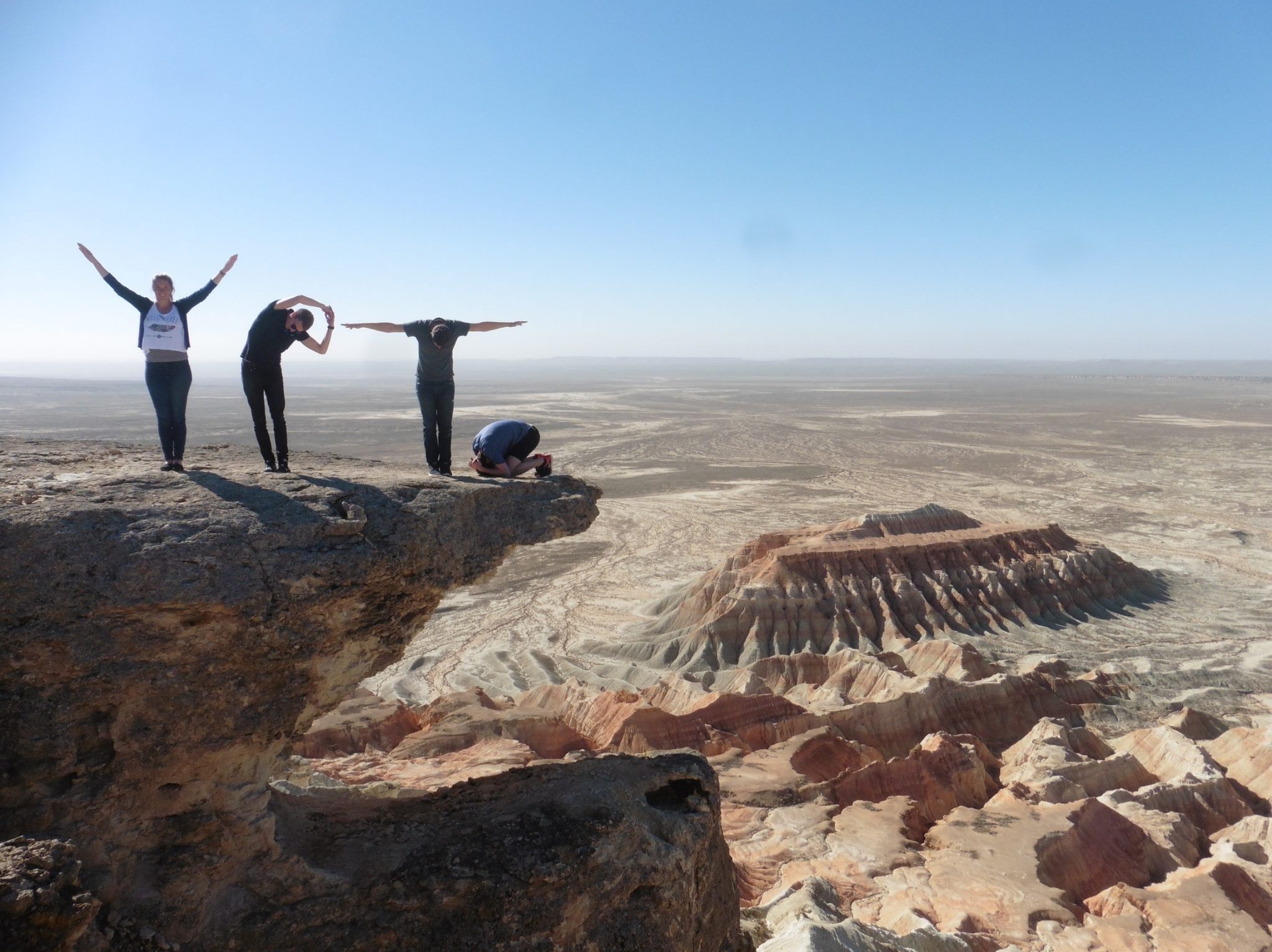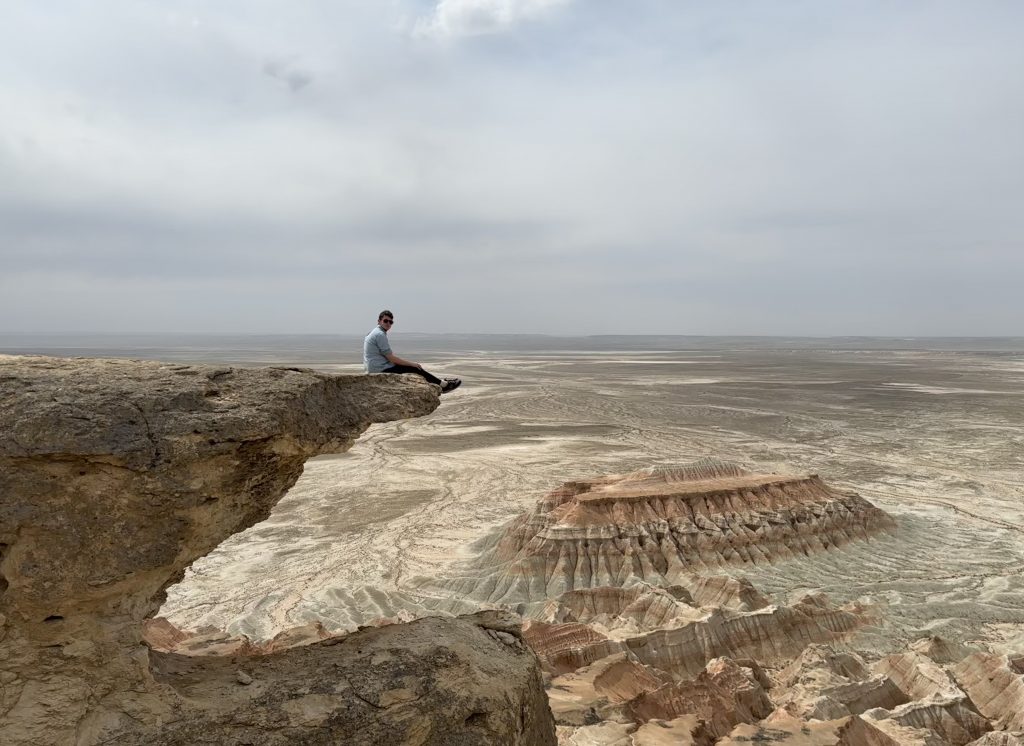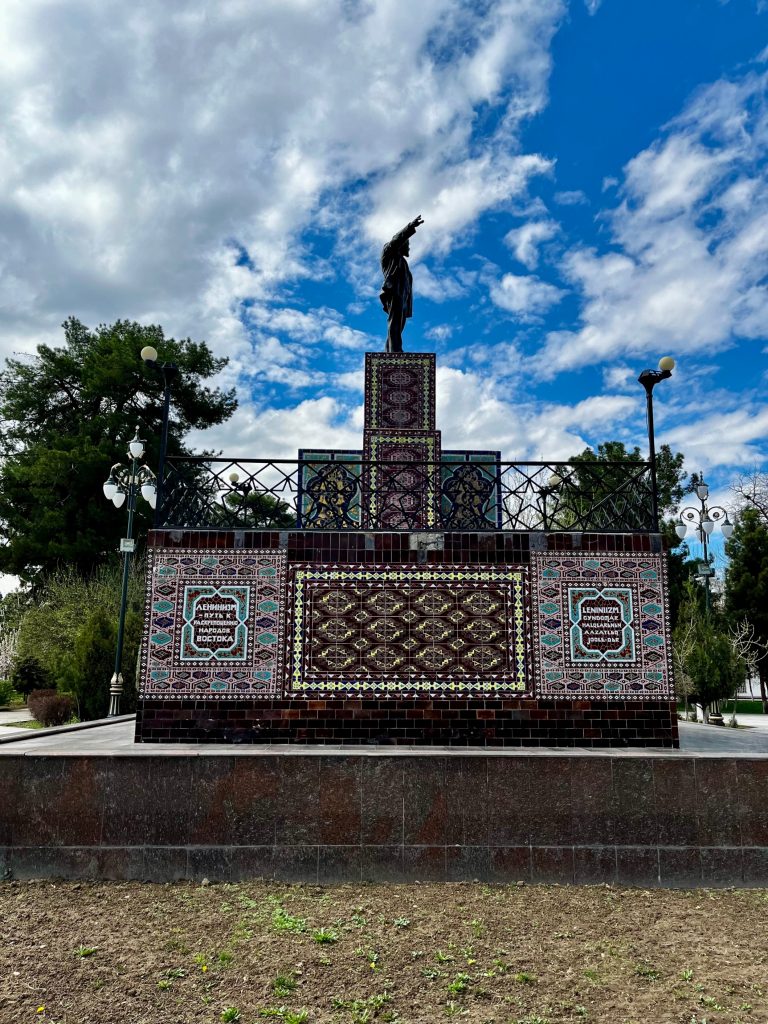When you think of Turkmenistan, you probably picture the surreal, white marble city of Ashgabat, with its deserted streets and gleaming buildings. Perhaps your thoughts linger on the capital’s numerous golden statues, grand monuments, or even that bizarre indoor Ferris wheel. And if your mind ventures beyond the city, it might produce images of the Darwaza Gas Crater — one of the Soviet Union’s most infamous manmade disasters, a place often described as “the Gates to Hell.” Your idea of Turkmenistan tourism maybe doesn’t venture further than this.


Turkmenistan Tourism has grown exponentially since their reopening after the COVID-19 pandemic. But Turkmenistan is much more than meets the eye. For those who scratch just a little beneath the surface, the barren desert quickly gives way to a multitude of fascinating natural wonders, ancient archaeological sites, and Silk Road treasures that you will likely be one of the first to discover!
Table of Contents
Yangykala Canyon:
In the far northwest of the country lies the Yangykala Canyon, a truly magnificent site. Emerging from the barren Karakum Desert, the landscape transforms into towering rock formations that have been shaped by erosion over five million years. Not only this, but the earth now reveals its colourful layers, jagged and sculpted by time. You are descending into what was once a seabed but is now a vast depression lower than the Caspian Sea. The terrain is expansive yet enclosed, creating a unique and awesome environment.
Until less than two decades ago, few Turkmen—let alone outsiders—were unaware of this place, a situation as bizarre as the average American being oblivious to the Grand Canyon. However, with the rise of social media (yes, even in Turkmenistan!), Yangykala has finally started to attract attention after having waited millions of years. Despite this, don’t expect crowds of tourists, as this remote site requires a 4×4 for access. Yangykala is one of Turkmenistan’s most unique attractions, which is why we make the effort to bring many of our groups here!

Awaza Tourist Compound:
The Awaza Tourist Compound is located on the Caspian Sea, just north of the city of Turkmenbaşy. The streets – void of pedestrians and even other cars – are frankly eerie, despite the roads being lined with public hotels owned by Turkmenistan’s government.
While visitors are not permitted to stay overnight in the tourist compound (a rule that came out of the COVID-19 pandemic), you can enter for a day trip, assuming you are in a registered vehicle with the correct permits.
However – at least in the summertime – what at first appears as a ghost town becomes a place that is distinctly more lively. Walking through the grand hotel lobbies, past their pools, and onto the beach, you can view the vast Caspian Sea. When it’s warm out, it’s a very pleasant place to swim and a local hot spot for parties. Turkmen and Russians drink beer, play sports on the beach, and listen to global house music on the beach. You can buy 1.25 litres of (very drinkable) local beer for 60 manat, which is barely $3. We also strongly recommend the fresh and local seafood, such as salt fish and shrimp!
The atmosphere feels more like a European beach destination and is one of the more unusual, unexpected parts of Turkmenistan!
Merv (and Mary):
Merv is a city as old as time, having been under the control of no less than six of civilization’s greatest empires. By the 12th century, it had become the most populated city in the entire world. Today, the ruins of Merv are extremely vast and well-preserved, and can also be visited as an easy day trip from Ashgabat or on the way to the Farap border crossing with Uzbekistan.
You can read more about our Merv and Mary day trip extension here, but there’s a reason that so many Pioneers take advantage of it. With flights from Ashgabat to the provincial capital of Mary taking just 45 minutes, you can check out a smaller Turkmen city very different from Ashgabat before making your way 35km east to Merv.
You’ll see the imposing remains of the Erk Kala, which has walls that are over 20m high and 2,500 years old, as well as the Kyz Kala, the symbol of the city and what many consider the best-preserved mud-brick fortress in the world. Furthermore, and in a nod to Central Asia being at the crossroads of the world, you can still make out the ruins of Islamic, Christian and even Buddhist places of worship within the city.
In short, a visit to Mary and Merv is the perfect way to start or end your Turkmenistan adventure.
Flying on Turkmenistan Airlines:
Okay, so you’re probably wondering why an airline has made it onto this list. Even for those of us with favourite carriers, flying is usually more about getting from A to B as quickly as possible, rather than a leisure activity done for its own sake.
Enter Turkmenistan Airlines. Most of our tours involve a trip on the national carrier at some point (the country is the size of Spain after all) but there’s a reason our itineraries promote it as an attraction in its own right.
From their hub in Ashgabat, you can experience “the alternative” before you even board the plane. The terminal is enormous, built out of white marble and shaped like a falcon – yet is almost entirely empty.
Once onboard, you’re transported to a different world, welcomed by traditional Turkmen music over the loudspeakers and planes with a very generous seat-to-passenger ratio. While the president’s portrait no longer graces the front of the cabin, you’ll find one as soon as you open the inflight magazine. In the latest edition, they boldly declare their wish to “be the best at everything in every field” – so I guess self-belief is half the battle! And yes, you even get a snack on short domestic flights! All in all, the inflight service could be described as very… atmospheric.
Before COVID, the airline had a niche but oddly logical network of routes. Growing up, they were by far the most unusual carrier operating from my home city of Birmingham. Sadly, this was not because Peaky Blinders and Ozzy Osbourne had become big in Turkmenistan, but because they filled a gap in the market, flying our Punjabi community straight to Amritsar via a quick connection in Ashgabat.
While (tragically) that route is no more, you can still take advantage of their flights across Asia to enjoy a minibreak in Ashgabat en route to your next Thai beach vacation. With the demise of the Turkmen transit visa, this is the only way to set foot on Turkmen soil without going through the entire tourist visa process.
Wondering why you can’t find these flights online? You’re not going crazy – they’re only available through licensed agents and some sketchy Facebook ads we wouldn’t recommend. But don’t worry, we can help you book tickets with Turkmenistan Airlines at the best price.
Kow Ata – Underground Sulphur Lake:
Situated on the Turkmenbaşy – Ashgabat highway, this is a legendary place in Turkmen mythology. The lake is said to have waters that reduce aging and cure various health problems, but we love it as a spot to mingle with ordinary citizens. Many of them have come from the capital for a weekend getaway and, if you’re lucky, you may even stumble upon a wedding party!
We’ll admit that the hundreds of steep steps, bats, strong smell of sulphur, and the sight of middle-aged Turkmen men in their underwear may be an acquired taste. But, as your mother always said, you should try everything at least once – that is certainly true of Kow Ata.
Kyrk Gyz Cave:
Located in Turkmenistan’s extreme southeast—near both Afghanistan and Uzbekistan—this is an isolated place even by Turkmen standards. The entrance to the cave lies in a beautiful green valley and appears unassuming at first, but quickly opens into a vast grotto covered by stalactites of cloth.
Known in English as “Forty Girls Cave,” the local legend tells of forty girls who once hid in this grotto to escape nearby thugs. There, an old woman cared for them, so many people today visit the cave in pilgrimage to honour her. Her tomb is marked by a footprint that looks very different from the ones of a modern person.
As for the cloth? Its connection to the original story remains a mystery. However, it’s said that if you attach a piece of cloth to some mud, throw it, and it then sticks to the ceiling, your wish will be granted. You may struggle to find scientific backing for this, but we think it’s a cute story and a site well worth the visit.
Nokhur Cemetery:
Few communities in the USSR escaped the relentless Soviet push to “modernize,” but the village of Nokhur was one of them. Nestled in the high and beautiful mountains, this village was allowed to retain its unique customs. Central Asia’s form of Islam has traditionally been deeply influenced by Sufism and pre-Islamic beliefs, and nowhere is this more apparent than in Nokhur.
The villagers have likely revered mountain goats since the time of Alexander the Great, adorning their graves with goat horns in the hope of warding off evil spirits. While entering the graveyard is discouraged out of respect, you can still admire from outside how the villagers have preserved their distinctive rites and traditions. The graves, often also decorated with both the Islamic star and crescent and the Communist red star, offer a fascinating glimpse into the village’s complex history.

Konye-Urgench:
Turkmenistan isn’t widely known for hosting some of humanity’s greatest cities, but this is exactly what Konye-Urgench was. From the 11th to 14th century, it was one of the most spectacular settlements on earth. The legendary Ibn Battuta even described it as “the largest, greatest, most beautiful and most important city” in the vast Turkic world.
Sadly, a lot of the ancient city has been in disrepair since the 18th century, but this is also part of its appeal. You can stand in the middle of the vast open areas, between the buildings that are left, and be able to imagine and appreciate the scale of the city in its heyday. Everything you see is entirely original, avoiding the over-restoration – even Disneyfication – that visitors in other Silk Road cities (such as Samarkand) complain of.
Unquestionably, the city’s highlight is the thousand-year-old Kutlug Timur Minaret which, at 60 metres, is the tallest in Central Asia. With Konye-Urgench just a few kilometres from the Uzbek border, it will likely be the first (or last) place you visit in Turkmenistan. You can hop across to Khiva or Nukus to continue your exploration of the Silk Road’s cities or take advantage of the many daily flights from neighbouring Daşoguz to Ashgabat.
Dinosaur Plateau:
We will now add paleontology to the list of things Turkmenistan isn’t (but should be) known for.
Nestled among some of the country’s highest mountains, and conveniently close to the Kyrk Gyz Cave, lies the Dinosaur Plateau. This limestone slab, measuring just 400 by 300 meters, contains over 3,000 footprints—the highest concentration of dinosaur tracks in the world.

These tracks were formed when various dinosaurs walked across a shallow lake, which, when it dried up, allowed their imprints to be baked by the sun and preserved in the rock. Many of the footprints found here are unique, with no known equivalents anywhere else in the world.
As for the name? The nearest village is called Hojapil, which means “sacred elephants” in Turkmen. According to local legend, these prints were made by elephants brought by Alexander the Great during his conquest of Asia.
Balkanabat:
What makes Balkanabat extraordinary is that it’s possibly the closest you will get to experiencing “ordinary” life in a Turkmen provincial city. Yes, there are marble buildings, but they are fewer and on a much smaller scale than in Ashgabat or even Turkmenbaşy. Instead, the city remains mostly comprised of quaint Soviet apartment blocks organized around a central courtyard. A “monument to desert explorers” takes pride of place in Balkanabat’s “downtown.”
It’s also a pretty diverse place. We’ve seen Azeris, Russians, Georgians, and Kazakhs chatting away in the central market, itself a great place to people-watch and interact with locals. Balkanabat is also conveniently located on the overnight train line from Turkmenbaşy to Ashgabat and is scenically located against a backdrop of mountains.


Feeling Inspired for some Turkmenistan Tourism?
We’ve been offering tours to Turkmenistan for over a decade, so through the years we have gotten to know the country very well – especially the alternative parts of it! Depending on the group tour, we visit many of these locations, although the longer it is the more we are able to see. However, if those dates don’t work for you, or you particularly want to see one of these “alternative” places, then we can organize a private tour for you. We recommend checking out our Turkmenistan page here, or getting in contact with us if you have any questions!





